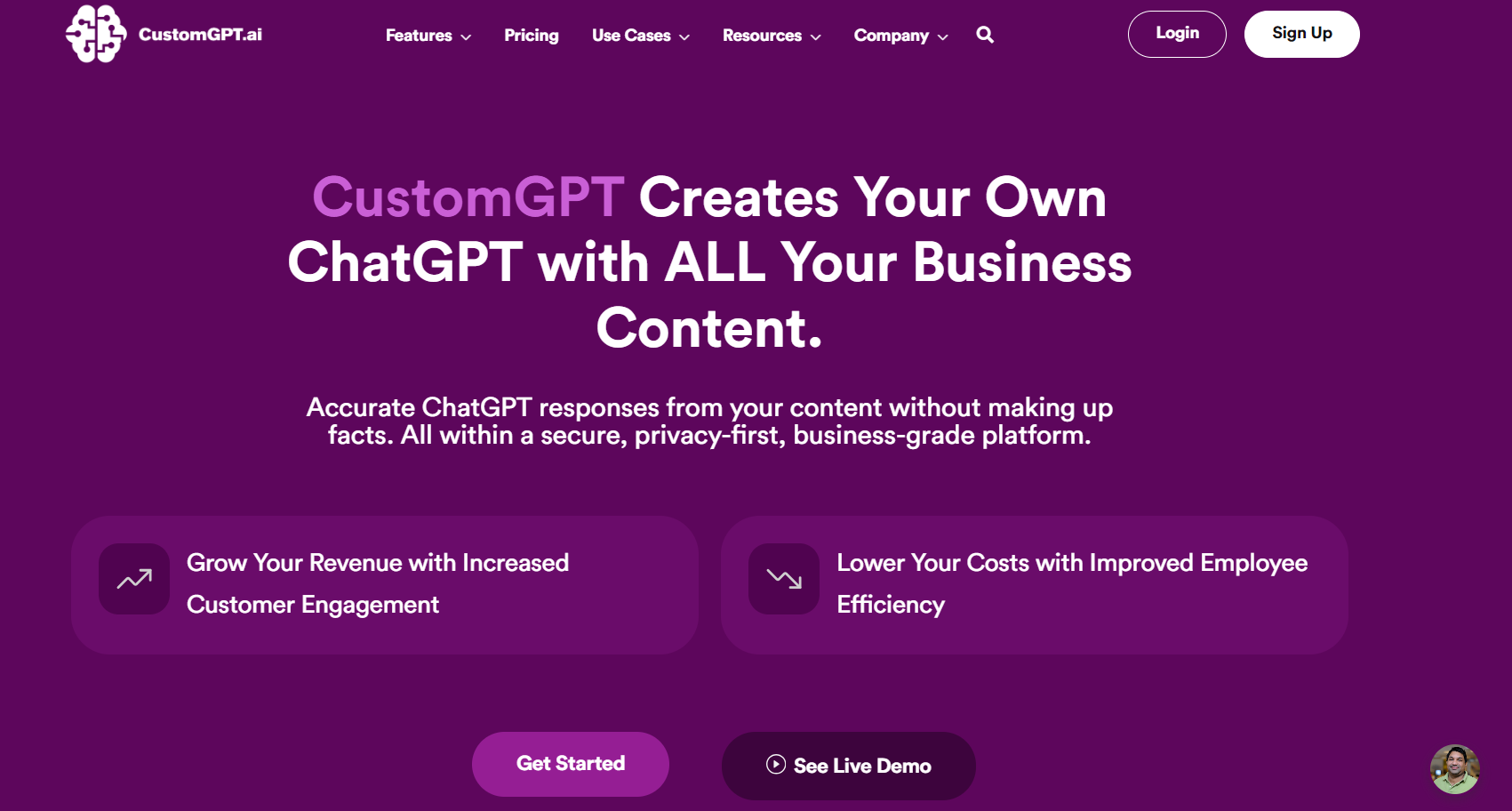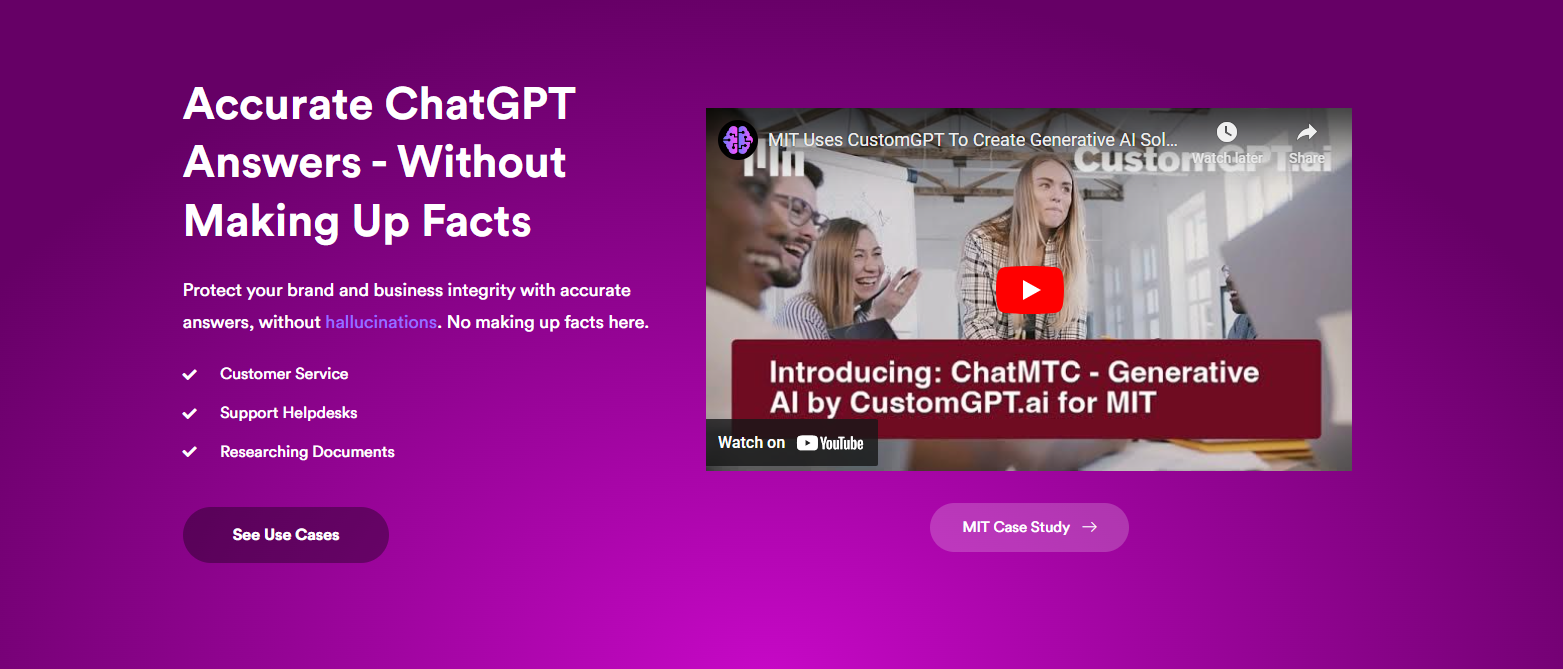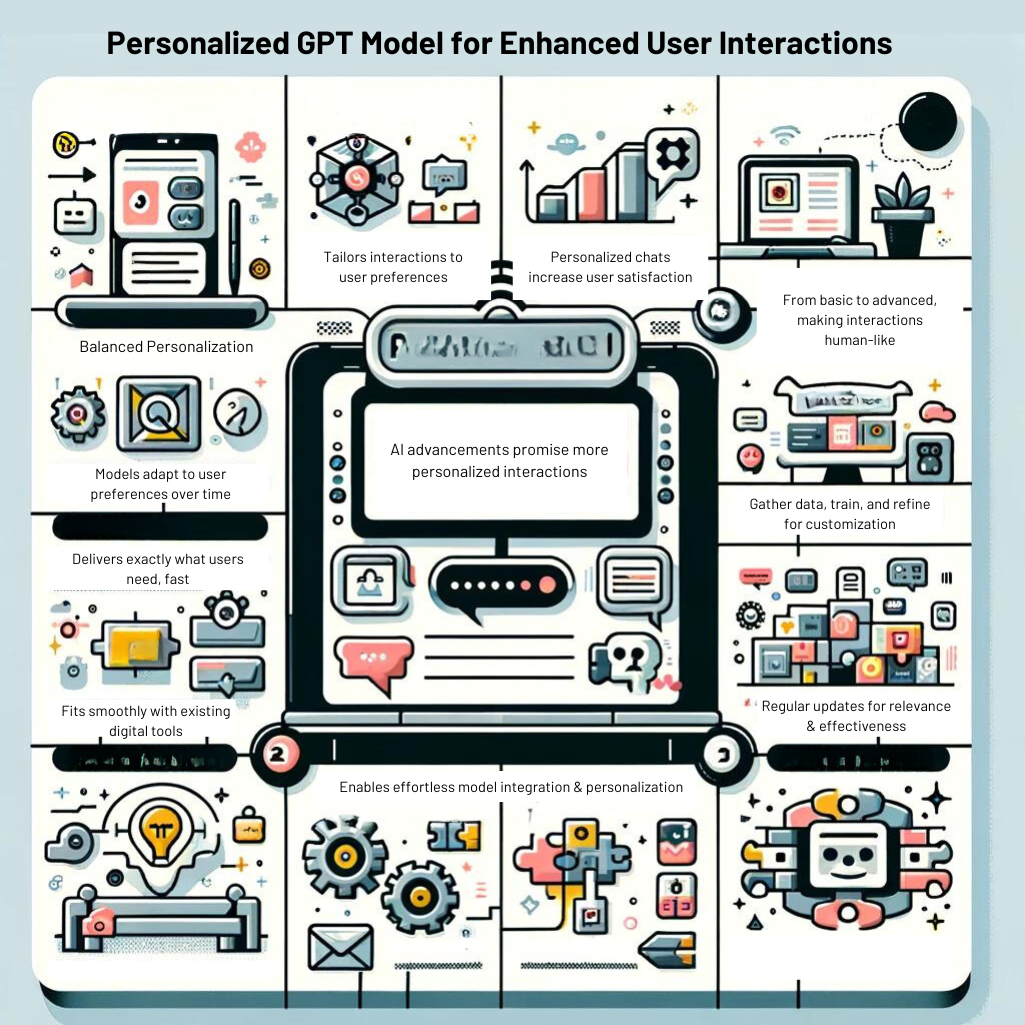
Imagine you’re at a bustling coffee shop, trying to order your favorite drink through a digital kiosk. But instead of the usual clunky interface, you’re greeted by a chatbot that not only remembers your last order but also suggests a new pastry you might like based on your preferences.
This isn’t just any chatbot; it’s powered by a personalized Custom GPT model, designed to enhance your interaction and make your experience as smooth and enjoyable as possible.
In the world of digital communication, the one-size-fits-all approach is quickly becoming obsolete. Businesses and developers are turning towards creating personalized GPT models to offer a unique, tailored experience for each user.
This blog post will dive into how these personalized Custom GPT model for enhanced user interactions, making digital platforms more intuitive, engaging, and human-like than ever before.

The Evolution of GPT Models
GPT models have come a long way, and it’s been quite the journey. Remember when we first heard about AI being able to write like humans? It sounded like something out of a sci-fi novel. But then, GPT-1 came along, and it was like watching a baby take its first steps.
Sure, it stumbled here and there, but the potential was undeniable. Fast forward, and each version of GPT has been like watching that baby grow up, getting smarter and more capable.

Now, with the latest versions, it’s like having a super-smart friend who can chat about almost anything. This evolution isn’t just cool; it’s revolutionary. It’s changing how we interact with machines, making them more like us. And that’s a game-changer for user interactions.
Benefits of Personalization in GPT Models
Let’s talk about why personalization in GPT models is a game-changer. Imagine walking into a party and everyone knows your name, your favorite drink, and even the kind of jokes you like.
That’s personalization at its best, and it’s exactly what Custom GPT model can do for enhanced user interactions.
With personalization, these models can tailor conversations, recommendations, and support to fit each user’s unique needs and preferences. This isn’t just about making users feel special; it’s about efficiency and relevance.

By understanding and anticipating what users want, personalized GPT models cut through the noise, delivering exactly what’s needed at lightning speed. It’s like having a personal assistant who knows you inside out, ready to help at a moment’s notice.
Understanding GPT and Personalization
Did you know that the first time you interact with a GPT model, it’s like meeting a stranger who knows nothing about you? Yet, imagine this stranger quickly learns your likes, dislikes, and even your quirky habits. That’s the magic of personalization in GPT models.
It transforms a generic AI interaction into a deeply personalized conversation, making you feel like it’s been tailored just for you.

This section dives into the nuts and bolts of GPT models and the wizardry behind personalization. We’ll explore how these technologies are not just changing the way we interact with machines but are also setting a new standard for user experience.
Get ready to see how a blend of advanced AI and a touch of personalization can create interactions that are not just smart, but also incredibly intuitive and engaging.
What is a GPT Model?
Ever wondered how chatting with an AI feels so real? That’s the magic of GPT models at work. Picture this: you’re typing away, asking questions or seeking advice, and back comes a response so spot-on, it’s like you’re texting a friend. This isn’t just any friend, though.
It’s a GPT model – a type of AI that’s been fed a feast of words, learning from a vast library of text across the internet. It’s like it’s read every book, article, and tweet ever written.
So, when you chat with a GPT model, it’s pulling from this massive pool of knowledge to chat back. It’s not just repeating lines; it’s creating new, relevant responses on the fly. Pretty cool, right?

The Role of Personalization
Diving into the world of GPT and personalization, it’s like stepping into a Tailor’s shop where everything is customized just for you.
Personalization is the secret sauce that makes interactions with GPT models not just smart, but incredibly relevant and engaging. It’s about turning a one-size-fits-all conversation into a one-on-one chat that feels as if it’s been crafted just for you.
That’s personalization at its best, and it’s exactly what Custom GPT model can do for enhanced user interactions.

Imagine a chatbot that remembers your last conversation, knows your preferences, and can even predict what you might need next. That’s the power of personalization. It transforms a simple interaction into an experience, making technology feel a little more human and a lot more helpful.
Steps to Create Your Personalized GPT Model
Ever felt like you’re just another face in the crowd, especially when interacting with digital platforms? Well, you’re not alone. The craving for personalized experiences is real and growing. That’s where creating your own personalized GPT model comes into play.
It’s like having a digital assistant that knows you better than you know yourself, ready to cater to your every whim. In the next few steps, I’ll walk you through how to turn this dream into a reality.
From gathering your data to training your model, each step is designed to bring you closer to a GPT model that feels uniquely yours. Get ready to dive into a world where your digital interactions are as personal as a chat with a good friend.

Gathering and Preparing Your Data
Starting your journey towards a personalized GPT model feels a bit like being a detective. You’re on a mission to gather clues (aka data) that will help your model understand exactly what you need from it.
This step is crucial because the quality of your data directly influences how well your GPT model performs. Think of it as cooking a gourmet meal; the fresher your ingredients, the better the taste.
So, dive into collecting data from various sources like customer reviews, social media, or even your own business insights. But remember, it’s not just about collecting data; it’s about preparing it too.
This means cleaning it up, organizing it, and making sure it’s in the right format for your GPT model to digest. It’s a bit of work, sure, but it’s also where the magic starts to happen.
Training Your Model
Once you’ve gathered all your data, it’s like you’ve got all the ingredients laid out on the kitchen counter, ready to cook up something amazing. Training your personalized GPT model is where the magic happens.
It’s where you take all that raw data and start teaching your model how to understand and respond in a way that’s tailored just for you or your business. This step is a bit like teaching a new employee about how things work around here.
You’ll use examples, correct mistakes, and gradually, your model starts getting the hang of it. It’s a process that requires patience and a bit of trial and error, but when you start seeing your model interact in a way that feels almost human, it’s incredibly rewarding.
Remember, the goal here is to create a model that knows your needs inside out, making every interaction feel personal and intuitive.
Testing and Refining the Model
After you’ve put in the hard work of training your model, it’s like you’ve just baked a cake. But before you serve it, you need to taste it to make sure it’s just right. This is what testing and refining your model is all about.
You start by throwing different types of questions and prompts at it, seeing how well it responds. Sometimes, it’ll surprise you with its accuracy and insight. Other times, it might miss the mark. That’s totally okay!
This phase is all about identifying those areas where your model could use a little more training. It’s a bit like teaching a student; with each test, you find out what they don’t know, and then you teach them that.
So, keep tweaking, keep testing, and soon, you’ll have a model that feels like it truly understands you and your needs.
Implementing Your Custom GPT Model for Enhanced User Interactions
Imagine this: You’ve just crafted a GPT model so personalized it feels like it’s part of your team. Now, it’s time to bring this digital genius into the real world, enhancing how you interact with your users.
This step is where the rubber meets the road, transforming your hard work into tangible benefits. By implementing your model, you’re not just introducing a new tool; you’re revolutionizing the way your business communicates.
Whether it’s answering customer queries with unprecedented accuracy or offering personalized recommendations that hit the mark every time, your model is about to become your MVP.
That’s personalization at its best, and it’s exactly what Custom GPT model can do for enhanced user interactions.
So, let’s dive into how you can seamlessly integrate this game-changing technology into your user interactions, ensuring every conversation is more meaningful, helpful, and human than ever before.

Integration with Existing Systems
Bringing your personalized GPT model into the fold with your existing systems is like introducing a new friend to your close-knit group. It’s exciting but needs a bit of finesse to ensure everyone gets along.
The beauty of platforms like CustomGPT.ai is their flexibility. They’re designed to play nice with what you already have in place, whether it’s your CRM, email marketing software, or customer service tools.
This step is crucial because it’s where your model goes from being a cool project to a vital part of your daily operations. It’s about making sure the new kid on the block can sync up with your team, share insights, and ultimately, enhance the way you interact with your users.
With a smooth integration, your personalized GPT model won’t just fit in; it’ll feel like it’s always been part of the team.
Monitoring and Continuous Improvement
Once your personalized GPT model is up and running, the journey doesn’t end there. Think of it as planting a garden. You wouldn’t just plant seeds and walk away, right?
You’d water them, pull out the weeds, and maybe even talk to them to help them grow. That’s exactly how you should treat your GPT model.
Keep an eye on how it’s performing, gather feedback from users, and look for those little tweaks that could make a big difference. This ongoing process ensures your model stays relevant and continues to provide value.
Plus, it’s a great way to show your users that you’re committed to improving their experience. So, roll up your sleeves and get ready to make your GPT model the best it can be, one update at a time.
Best Practices for Personalized GPT Models
Did you know that the most memorable interactions you’ve had online were likely powered by AI? That’s right, behind every “how can I help you?” there’s a smart algorithm working tirelessly.
But here’s the kicker: not all AI interactions are created equal. The secret sauce? Personalization. In this section, we’ll dive into the best practices for crafting personalized GPT models that don’t just talk at your users, but truly engage with them.
From understanding your audience’s unique needs to fine-tuning your model’s responses, we’re covering all the bases.
So, whether you’re looking to boost customer satisfaction, drive engagement, or simply make your digital presence more human, you’re in the right place. Let’s make your AI interactions unforgettable.

Ensuring Data Privacy and Security
When diving into the world of personalized GPT models, it’s like opening a treasure chest. But, remember, with great power comes great responsibility. Ensuring data privacy and security is not just a checkbox; it’s the cornerstone of trust between you and your users.
CustomGPT.ai shines here, offering a fortress for your data. It’s like having a digital vault where only you have the key. With features like full encryption and a strict no-data-storage policy, CustomGPT.ai ensures that your interactions remain confidential and secure.
That’s exactly what GPT model can do for enhanced user interactions. So, you can focus on creating those engaging, personalized experiences, knowing your data privacy and security are in ironclad hands.
Balancing Personalization and User Comfort
When we talk about personalization, it’s like walking a tightrope. On one side, you’ve got the thrill of creating something that feels like it’s made just for the user. On the other, there’s the risk of stepping too close to the edge and making them uncomfortable.
The key? Knowing your audience like the back of your hand. It’s about striking that perfect balance where your GPT model knows enough to be helpful, but not so much that it feels intrusive.
Think of it as being a thoughtful friend who remembers your likes and dislikes, not a nosy neighbor who knows a little too much. That’s exactly what Custom GPT model can do for enhanced user interactions.
With CustomGPT.ai, we’ve got the tools to help you walk that line with confidence, ensuring your personalized interactions are always on the right side of personal.

FAQ
1. What are the key benefits of creating a personalized GPT model for my business?
Creating a personalized GPT model for your business brings a host of benefits that can significantly enhance your customer interactions and overall business performance. Here are some key advantages:
- Enhanced Customer Engagement: Personalized GPT models can interact with your customers in a more meaningful and relevant manner. By understanding and responding to individual preferences and behaviors, these models can create a more engaging and satisfying experience for your customers.
- Efficient Knowledge Management: With the ability to integrate multiple data sources, personalized GPT models streamline knowledge management. This efficiency leads to faster and more accurate responses, improving your customer service and support.
- Global Reach with Inclusive Interactions: The language support feature of personalized GPT models ensures that your business can engage with a diverse customer base globally. This not only expands your market presence but also fosters stronger connections with customers through more meaningful and inclusive interactions.
- Seamless Communication and Consistency: Personalized GPT models provide a consistent user experience across various touchpoints. This seamless communication ensures that customers receive tailored suggestions and support, enhancing the overall user experience and satisfaction.
- Data Privacy and Security: A personalized GPT model prioritizes user data privacy and security, building trust among users. This commitment to privacy assures customers that their information is handled securely and in compliance with privacy standards.
By leveraging these benefits, businesses can create more personalized, efficient, and secure interactions with their customers, leading to increased satisfaction and loyalty.
2. How can I ensure my personalized GPT model aligns with my brand voice and tone?
Ensuring your personalized GPT model aligns with your brand voice and tone is crucial for maintaining consistency and authenticity in your customer interactions. Here are some steps to achieve this:
- Train with Business-Specific Data: Start by feeding your GPT model with data that reflects your brand’s unique voice and tone. This includes customer service transcripts, product descriptions, and any other content that showcases your brand’s personality.
- Customize Language and Tone Settings: Use the customization features of platforms like CustomGPT.ai to adjust the language and tone settings of your GPT model. This ensures that the responses generated match your brand’s style, whether it’s formal, casual, or somewhere in between.
- Regular Updates and Improvements: Continuously update your GPT model with new data and feedback from customer interactions. This helps the model to learn and adapt, ensuring that it remains aligned with your brand voice and tone over time.
By following these steps, you can create a personalized GPT model that not only understands your products and services but also communicates in a way that resonates with your brand identity.
3. What are the best practices for training a personalized GPT model to understand my audience’s needs?
Training a personalized GPT model to understand your audience’s needs involves several best practices that ensure the model is both effective and aligned with your business goals. Here are some key strategies:
- Understand Your Customer Data: Begin by deeply analyzing your customer data. This includes preferences, purchase history, and any other relevant information that can provide insights into your audience’s needs and behaviors.
- Identify Key Elements: Based on your understanding of the customer data, identify crucial elements that are likely to interest your customers. This could be genres, authors, or topics for a bookstore; or product features and benefits for a tech gadget store.
- Define a Persona: Decide on the persona your chatbot should adopt. This persona should resonate with your brand and appeal to your target audience. It could be a friendly assistant, an expert advisor, or any character that fits your brand’s voice.
- Use Personalization Tokens: Incorporate personalization tokens in your prompts. This allows the model to dynamically insert customer-specific information, making interactions more personalized and relevant.
- Continuous Learning and Updating: Ensure your GPT model can learn from interactions and be updated with new information. This keeps the model relevant and improves its ability to understand and meet your audience’s evolving needs.
By following these practices, you can train your personalized GPT model to offer tailored, engaging, and effective interactions that meet your audience’s specific needs.
4. How do I integrate a personalized GPT model into my existing customer service and engagement platforms?
Integrating a personalized GPT model into your existing customer service and engagement platforms can significantly enhance your customer interactions. Here’s how you can do it, especially with a focus on using CustomGPT.ai, a platform known for its seamless integration capabilities and no-code approach.
- Assess Your Current Setup: Begin by evaluating your existing customer service and engagement platforms. Identify the touchpoints where a GPT model can add value, such as live chat, email responses, or social media interactions.
- Choose CustomGPT.ai for Integration: CustomGPT.ai stands out for its ability to integrate with a wide range of platforms without the need for extensive coding. Its API is included in all plans, allowing for straightforward integration with your current systems.
- Prepare Your Data: CustomGPT.ai thrives on data. Gather all relevant business content, including FAQs, product information, and customer service logs. This data will train your personalized GPT model to understand your business and customer needs better.
- Use the No-Code Visual Builder: With CustomGPT.ai, you can use the no-code visual builder to design your chatbot’s workflow. This step is crucial for ensuring that the GPT model aligns with your customer service objectives and brand voice.
- Integrate Using CustomGPT.ai API: Leverage the CustomGPT.ai API to connect the personalized GPT model with your existing platforms. Whether you’re using CRM software like Salesforce, marketing automation tools like Marketo, or any other customer engagement platform, CustomGPT.ai’s API facilitates smooth integration.
- Test and Optimize: Before going live, thoroughly test the integrated GPT model across different scenarios to ensure it responds accurately and helpfully. Use customer feedback and interaction data to continually refine the model for better performance.
By following these steps and leveraging CustomGPT.ai’s unique features, you can enhance your customer service and engagement platforms with personalized, efficient, and intelligent interactions.
5. What measures should I take to ensure data privacy and security when deploying a personalized GPT model?
When deploying a personalized GPT model, ensuring data privacy and security is paramount. Here are some measures you should consider, especially when using platforms like CustomGPT.ai, which prioritize these aspects:
- Data Encryption: Always ensure that your data is encrypted both in transit and at rest. CustomGPT.ai ensures your data is fully encrypted, making it unreadable to unauthorized users.
- Access Control: Implement strict access controls. CustomGPT.ai allows only authorized personnel to access critical data, ensuring that sensitive information remains secure.
- Minimize Data Collection: Collect only the data necessary for the functionality of your chatbot. CustomGPT.ai advocates for minimizing data collection to what’s essential, reducing privacy risks.
- Anonymity and Pseudonymity: Whenever possible, allow users to interact with your chatbot anonymously or under a pseudonym. This practice helps in safeguarding personal identities.
- Regular Audits and Updates: Conduct regular security audits and update your GPT model and its underlying systems to patch any vulnerabilities. This proactive approach helps in maintaining a robust defense against potential security threats.
- Anti-hallucination Technology: Utilize CustomGPT.ai’s anti-hallucination technology to ensure that the generated responses are accurate and relevant, minimizing the risk of generating misleading information that could compromise data privacy.
- User Consent and Transparency: Be transparent with your users about the data you collect and how it will be used. Ensure to obtain their consent before collecting personal information, aligning with privacy regulations like GDPR.
By implementing these measures, you can significantly enhance the privacy and security of your personalized GPT model, ensuring a safe and trustworthy environment for your users.
Conclusion
Did you know that the average person spends nearly two hours a day interacting with digital content? That’s a lot of scrolling, clicking, and reading. In this whirlwind of digital interaction, creating a personalized Custom GPT model for enhanced user interactions.
It’s not just about keeping up with the digital age; it’s about setting the pace. By tailoring interactions to each user, you’re not just another website or app—they’re engaging with a friend.
This journey through the ins and outs of personalized GPT models has shown us the power of customization and the impact it can have on user engagement.
Let’s wrap things up by reflecting on the key takeaways and how you can start implementing these strategies today.

The Future of Personalized GPT Models
The road ahead for personalized GPT models looks incredibly exciting. Imagine a world where every digital interaction feels like it’s tailored just for you. That’s not a distant dream; it’s the next step.
With advancements in AI, like those we’re seeing with CustomGPT.ai, these models are set to become even more intuitive, making our online experiences more engaging and personal than ever before.
They’ll learn from our behaviors, adapt to our preferences, and maybe even anticipate our needs before we articulate them.
The future is about breaking the one-size-fits-all mold and moving towards a digital landscape that feels uniquely ours. And with CustomGPT.ai leading the charge, we’re in for a thrilling ride.
- Creating a Custom GPT for Hobbyists: Photography, Painting, and More - March 21, 2024
- Developing a Tailored GPT Model for Blockchain and Cryptocurrency Education - March 21, 2024
- Customizing a GPT for Automotive Maintenance and Car Buying Advice - March 21, 2024




